Melaleuca penicula is a plant in the myrtle family, Myrtaceae and is endemic to the south of Western Australia. It is a rare species only known from the Fitzgerald River National Park and resembles Melaleuca eximia with its spikes of red flowers but its leaves and stamen bundles are different.

Melaleuca amydra is a plant in the myrtle family, Myrtaceae and is endemic to the south-west of Western Australia. It is similar to Melaleuca ryeae with its small, compact form, oval leaves and "pom-pom" heads of pink to purple flower heads on the ends of the branches in spring.
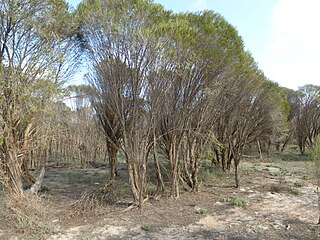
Melaleuca atroviridis is a plant in the myrtle family, Myrtaceae and is endemic to the south-west of Western Australia. It was formerly included in the species Melaleuca uncinata but a review of that species lead to the identification of a number of new species. Like M. uncinata, this species is used for the production of brushwood fencing. It has fewer stamens in the flowers and somewhat smaller clusters of fruit but has the same needle-like leaves with a hooked end and spikes of creamy yellow flowers in early summer.

Melaleuca campanae is a plant in the myrtle family, Myrtaceae and is endemic to the south-west of Western Australia. It is a small, woody shrub similar to Melaleuca eulobata, with a low, spreading habit and pinkish flower heads but it has longer, pointed leaves and lacks distinct sepals which instead form a ring of tissue around the edge of the flowers.
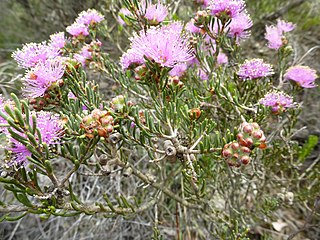
Melaleuca carrii is a plant in the myrtle family, Myrtaceae and is endemic to the south-west of Western Australia. It is a small shrub similar to Melaleuca pentagona, with "pom-pom" heads of pinkish flowers and sharply pointed leaves but it is generally smaller, lacks a groove in its leaves and retains its petals on the flowers for longer than that species.
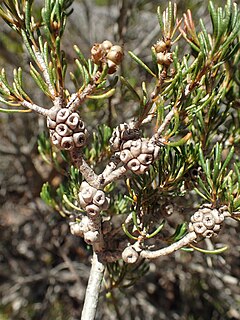
Melaleuca clavifolia is a plant in the myrtle family, Myrtaceae and is endemic to the south-west of Western Australia. It is a small shrub similar to Melaleuca tinkeri, with "pom-pom" heads of pinkish flowers and soft, silky hairs on the new growth but it has larger flower heads and its leaves are shorter, more club-shaped and have less distinct oil glands.

Melaleuca croxfordiae is a plant in the myrtle family, Myrtaceae and is endemic to the far south-west of corner Western Australia. It is a paperbark, usually growing in winter-wet places, with long, narrow leaves and a few small creamy coloured flower heads in early summer.
Melaleuca eximia is a plant in the myrtle family, Myrtaceae and is endemic to the south of Western Australia. It is distinguished by its leaf arrangement, its large, showy red inflorescences and the large, furry bracts under the flowers.

Melaleuca exuvia is a plant in the myrtle family, Myrtaceae and is endemic to the south of Western Australia. It is easily distinguished by its unusual rough, minni ritchi bark which peels to reveal a new layer of smooth, salmon-pink bark. It is a newly described (2004) species which was formerly included in Melaleuca uncinata.

Melaleuca fabri is a plant in the myrtle family, Myrtaceae and is endemic to the south-west of Western Australia. It features strap-like leaves with distinct veins and spikes of pinkish flowers, the buds of which are covered with short, soft, silky hairs.
Melaleuca grieveana is a plant in the myrtle family, Myrtaceae and is endemic to the south-west of Western Australia. It is similar to Melaleuca brophyi with its heads of yellow flowers and almost cylindrical leaves. The main difference is that the leaves of this species, but not those of Melaleuca brophyi are covered with soft hairs.

Melaleuca hnatiukii is a plant in the myrtle family, Myrtaceae and is endemic to the south of Western Australia. It is a medium to large shrub with arching branches, prickly tipped leaves and creamy-white heads of flowers in spring or early summer.
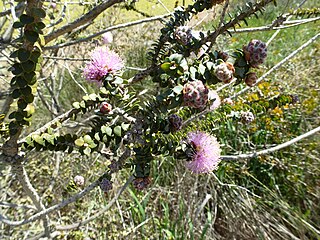
Melaleuca orbicularis is a plant in the myrtle family, Myrtaceae and is endemic to the south-west of Western Australia. It is similar to Melaleuca cordata with its pinkish "pom-pom" heads of flowers but its leaves are smaller, almost circular compared to the heart shaped leaves of the other species.

Melaleuca osullivanii is a plant in the myrtle family, Myrtaceae and is endemic to the south-west of Western Australia. It was first formally described in 2004 after a review of the broombush group, Melaleuca uncinata. It differs from others in the group by having leaves that are fine and circular in cross section. The closest other broombrush is Melaleuca hamata whose leaves are 0.8–1.6 mm (0.03–0.06 in) in diameter compared to 0.7–0.9 mm (0.03–0.04 in) for this species.

Melaleuca phoidophylla is a plant in the myrtle family, Myrtaceae and is endemic to the south-west of Western Australia. It is distinguished by its leaf arrangement, small raised blisters on the leaves and heads of white or cream flowers on the ends of the branches in spring.
Melaleuca procera is a plant in the myrtle family, Myrtaceae and is endemic to the south-west of Western Australia. It is an erect, spindly shrub with cylinder-shaped leaves and heads of pinkish flowers in later spring or early summer.
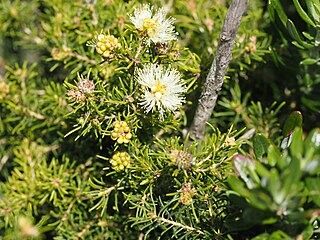
Melaleuca systena, commonly known as coastal honeymyrtle is a plant in the myrtle family, Myrtaceae and is endemic to the south-west of Western Australia. It was previously known as Melaleuca acerosa. It is a small shrub with crowded foliage and profuse heads of white to yellow flowers on the ends of its branches in spring.
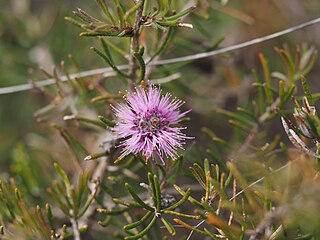
Melaleuca tinkeri is a plant in the myrtle family, Myrtaceae and is endemic to the south-west of Western Australia. It is one of the smallest melaleucas and is distinguished by its warty, hairy leaves, heads of pinkish flowers in late winter to spring and its spherical fruiting clusters.
Melaleuca venusta is a shrub in the myrtle family Myrtaceae and is endemic to the west coast of Western Australia. It is a shrub with silvery leaves and heads of pink to purple flowers which fade to white and with a restricted distribution, north of the Murchison River district.
Melaleuca villosisepala is a shrub in the myrtle family Myrtaceae and is endemic to the south-west of Western Australia. It is a shrub with narrow leaves, heads of pink to mauve flowers that fade to white and is similar to Melaleuca wonganensis except that its heads of flowers are smaller and pinkish rather than deep purple.
















